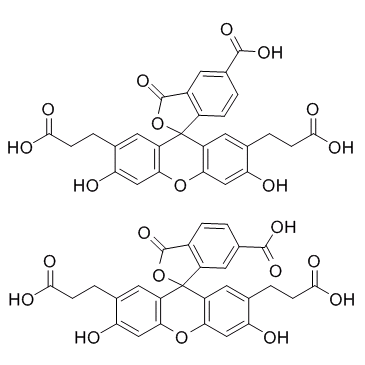BCECF

BCECF structure
|
Common Name | BCECF | ||
|---|---|---|---|---|
| CAS Number | 85138-49-4 | Molecular Weight | 520.44100 | |
| Density | 1.67g/cm3 | Boiling Point | 936.2ºC at 760mmHg | |
| Molecular Formula | C27H20O11 | Melting Point | N/A | |
| MSDS | USA | Flash Point | 318.2ºC | |
|
Local pH domains regulate NHE3-mediated Na⁺ reabsorption in the renal proximal tubule.
Am. J. Physiol. Renal Physiol. 307(11) , F1249-62, (2014) The proximal tubule Na(+)/H(+) exchanger 3 (NHE3), located in the apical dense microvilli (brush border), plays a major role in the reabsorption of NaCl and water in the renal proximal tubule. In response to a rise in blood pressure NHE3 redistributes in the ... |
|
|
Role of polyol moiety of amphotericin B in ion channel formation and sterol selectivity in bilayer membrane.
Bioorg. Med. Chem. 23 , 5782-8, (2015) Amphotericin B (AmB) is a polyene macrolide antibiotic widely used to treat mycotic infections. In this paper, we focus on the role of the polyol moiety of AmB in sterol selectivity using 7-oxo-AmB, 7α-OH-AmB, and 7β-OH-AmB. The 7-OH analogs were prepared fro... |
|
|
A novel effect of DMOG on cell metabolism: direct inhibition of mitochondrial function precedes HIF target gene expression.
Biochim. Biophys. Acta 1847 , 1254-66, (2015) Abnormal accumulation of oncometabolite fumarate and succinate is associated with inhibition of mitochondrial function and carcinogenesis. By competing with α-ketoglutarate, oncometabolites also activate hypoxia inducible factors (HIFs), which makes oncometab... |
|
|
HRG-1 enhances cancer cell invasive potential and couples glucose metabolism to cytosolic/extracellular pH gradient regulation by the vacuolar-H(+) ATPase.
Oncogene 33(38) , 4653-63, (2014) Haeme-responsive gene (HRG)-1 encodes a 16-kDa transmembrane protein that is induced by insulin-like growth factor-1 (IGF-1) and associates with the vacuolar-(H(+)) ATPase (V-ATPase). We previously reported that HRG-1 is essential for V-ATPase activity in end... |
|
|
Low CO2 permeability of cholesterol-containing liposomes detected by stopped-flow fluorescence spectroscopy.
FASEB J. 29 , 1780-93, (2015) Here we ask the following: 1) what is the CO2 permeability (Pco2) of unilamellar liposomes composed of l-α-phosphatidylcholine (PC)/l-α-phosphatidylserine (PS) = 4:1 and containing cholesterol (Chol) at levels often occurring in biologic membranes (50 mol%), ... |
|
|
Txnip ablation reduces vascular smooth muscle cell inflammation and ameliorates atherosclerosis in apolipoprotein E knockout mice.
Atherosclerosis 241 , 313-21, (2015) Inflammation of vascular smooth muscle cells (VSMC) is intimately linked to atherosclerosis and other vascular inflammatory disease. Thioredoxin interacting protein (Txnip) is a key regulator of cellular sulfhydryl redox and a mediator of inflammasome activat... |
|
|
Utilizing hydrogen sulfide as a novel anti-cancer agent by targeting cancer glycolysis and pH imbalance.
Br. J. Pharmacol. 171(18) , 4322-36, (2014) Many disparate studies have reported the ambiguous role of hydrogen sulfide (H2 S) in cell survival. The present study investigated the effect of H2 S on the viability of cancer and non-cancer cells.Cancer and non-cancer cells were exposed to H2 S [using sodi... |
|
|
Sulforhodamine B interacts with albumin to lower surface tension and protect against ventilation injury of flooded alveoli.
J. Appl. Physiol. 118(3) , 355-64, (2015) In the acute respiratory distress syndrome, alveolar flooding by proteinaceous edema liquid impairs gas exchange. Mechanical ventilation is used as a supportive therapy. In regions of the edematous lung, alveolar flooding is heterogeneous, and stress is conce... |
|
|
The dipeptidyl peptidase-IV inhibitor inhibits the expression of vascular adhesion molecules and inflammatory cytokines in HUVECs via Akt- and AMPK-dependent mechanisms.
Mol. Cell. Endocrinol. 405 , 25-34, (2015) Recently, dipeptidyl peptidase-IV (DPP-IV) inhibitor, a major anti-hyperglycemic agent, has received substantial attention as a possible therapeutic target for inflammatory diseases such as atherosclerosis. However, the direct molecular mechanisms through whi... |
|
|
Enhancement of binding kinetics on affinity substrates by laser point heating induced transport.
Analyst 141 , 1807-13, (2016) Enhancing the time response and detection limit of affinity-binding based biosensors is an area of active research. For diffusion limited reactions, introducing active mass transport is an effective strategy to reduce the equilibration time and improve surfac... |